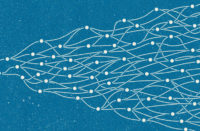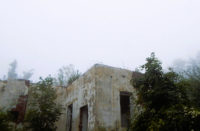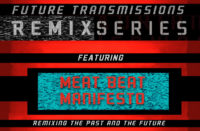
>>> Key
::..:::…..:..::….:::::..:::..:::::::……:::…::.:::….::::..:..:::…::…….::::
 :: At about eighteen minutes Chefkirk’s 3 is a rugged noise adventure.
:: At about eighteen minutes Chefkirk’s 3 is a rugged noise adventure.
The opening “Eyebase (Remix)” is a short-run frequency bend – like a hosefull of water over a dying battery. The scorching march of
“8minois” takes time to cozy up to, but within five or so minutes you
are forced to endure the terms of endearing rattle n’ hum of it all.
Unlike the recent (38-40cm) disc on Simple Logic, here this East Coast
noise addict keeps the palette within 100 or so shades of grey, building
a pretty dense and crumbly drone. His aesthetic has a very
weather-beaten, motorized quality, more of industrial science than
formal sound structure. But for all its concrete qualities, tracks like
“U” just drain my energy nucleous, rendering me a bit jello-like.
Chefkirk has captured the elements of wind and earth through a barbed
wire fence and recontorted its natural properties by filtering out the
good stuff. The second “Eyebase (Remix)” is the final and most animated
track on 3 that starts off with tones that pliably twist and turn like
a critter in a 70’s ‘B’ horror flick, switch off to make some rambunctious
noise and retreat into its wash of recycled microns – Godzilla vs.
Chefkirk in the battle of the sound barrier.
::..:::…..:..::….:::::..:::..:::::::……:::…::.:::….::::..:..:::…::…….::::
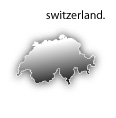 :: Going on 15 years, Swiss imprint Four 4 Ears Records has been releasing a constant body of quality, edgy, experimental sound that counters the mainstream diligently. This release is no different. This brings together three very disparate thinking and venerable composers: Oren Ambarchi (guitar and electronics), Günter Müller (Percussion, Electronics) and Philip Samartzis (Electronics and Field Recordings). The disc is broken into two lengthy tracks, “Cooler” and “Warmer” – both recorded in Melbourne. Part one is actually quite warm, given its foundation of low-fi white noise sound waves. With the cover art consisting of wacky neon-eyed vermin, some of the pitch-play may speak volumes to such creatures. If that were the case, the humor would be almost cartoonish, but the recording is far from any joke. In fact, these teeny collected noises make quite a dissonant field of microwave sound-alikes. I feel like a refugee in a lost rainforest, covered only by a tenuous cowhide tarp before a monsoon is about to search and destroy. So, yeah, “Strange Love” has a penetrable built-in atmosphere. Track one, however, shorts quite abruptly about 23 minutes through and continues with a whirring fan-belt sounding motor and panting sounds of leashed dogs and children roaring through a field of reeds as if searching for something terrifyingly lost. “Warmer” is set in the snug fit of a low burning campfire. A changing drone envelops like a cascading sphere of smoke and ash. What ensues is a pulsating surge of curiously psychedelic, elongated sine tones that phase into silence after about five minutes. Returning to the streets and fields, murmuring children, sparse construction and perhaps some ocean waves are overlapped in a cursory passage and then back to brighter high frequencies that veer dizzyingly from left to right. This is one of those collaborative projects that gets in your head and stays there.
:: Going on 15 years, Swiss imprint Four 4 Ears Records has been releasing a constant body of quality, edgy, experimental sound that counters the mainstream diligently. This release is no different. This brings together three very disparate thinking and venerable composers: Oren Ambarchi (guitar and electronics), Günter Müller (Percussion, Electronics) and Philip Samartzis (Electronics and Field Recordings). The disc is broken into two lengthy tracks, “Cooler” and “Warmer” – both recorded in Melbourne. Part one is actually quite warm, given its foundation of low-fi white noise sound waves. With the cover art consisting of wacky neon-eyed vermin, some of the pitch-play may speak volumes to such creatures. If that were the case, the humor would be almost cartoonish, but the recording is far from any joke. In fact, these teeny collected noises make quite a dissonant field of microwave sound-alikes. I feel like a refugee in a lost rainforest, covered only by a tenuous cowhide tarp before a monsoon is about to search and destroy. So, yeah, “Strange Love” has a penetrable built-in atmosphere. Track one, however, shorts quite abruptly about 23 minutes through and continues with a whirring fan-belt sounding motor and panting sounds of leashed dogs and children roaring through a field of reeds as if searching for something terrifyingly lost. “Warmer” is set in the snug fit of a low burning campfire. A changing drone envelops like a cascading sphere of smoke and ash. What ensues is a pulsating surge of curiously psychedelic, elongated sine tones that phase into silence after about five minutes. Returning to the streets and fields, murmuring children, sparse construction and perhaps some ocean waves are overlapped in a cursory passage and then back to brighter high frequencies that veer dizzyingly from left to right. This is one of those collaborative projects that gets in your head and stays there.
::..:::…..:..::….:::::..:::..:::::::……:::…::.:::….::::..:..:::…::…….::::
 :: Joshua Treble is the alter-persona of Ohio’s Tony Boggs and Five Points Fincastle is his sophomore effort for Montreal-based Intr_Version after recording for Pitchcadet. Airy and choppy, drone-based and choral-bitten this is part hangover and part yet to be told. “Distance Between Us in KM” is like Philip Jeck on speed; with a heaping portion of titillated lockgroove hooks. Through bold voids Joshua Treble inverts his worn guitar into something of a halo, catching every ray of light in its reflection, forming a projectile warning that is agitated and coarse. Wielding some fine pure white noise and the repetitive rings of multi-strike beats “A Serious House on Serious Earth” emerges from the horizon, somewhere on higher ground. Treble intangibly channels the ambience of Gas’ (Wolfgang Voigt) “Zauberberg,” the decelerated pace and transfixed, streaky tones play hide and seek, but the object of the action has stubbornly vanished. When he mutates his guitar strings alongside Jenna Robertson’s lovely vocal they wrap in synchronization like a tattered papoose whose strips are bare, with sensually durable contents. “The Hour Is Like The Room” keeps you captive like a fish being poked at behind in its filtered tank walls. The vibrations are wavy and jittery but the slow-mo settle shifts everything to slightly unrecognizable; A micro earthquake inside my head.
:: Joshua Treble is the alter-persona of Ohio’s Tony Boggs and Five Points Fincastle is his sophomore effort for Montreal-based Intr_Version after recording for Pitchcadet. Airy and choppy, drone-based and choral-bitten this is part hangover and part yet to be told. “Distance Between Us in KM” is like Philip Jeck on speed; with a heaping portion of titillated lockgroove hooks. Through bold voids Joshua Treble inverts his worn guitar into something of a halo, catching every ray of light in its reflection, forming a projectile warning that is agitated and coarse. Wielding some fine pure white noise and the repetitive rings of multi-strike beats “A Serious House on Serious Earth” emerges from the horizon, somewhere on higher ground. Treble intangibly channels the ambience of Gas’ (Wolfgang Voigt) “Zauberberg,” the decelerated pace and transfixed, streaky tones play hide and seek, but the object of the action has stubbornly vanished. When he mutates his guitar strings alongside Jenna Robertson’s lovely vocal they wrap in synchronization like a tattered papoose whose strips are bare, with sensually durable contents. “The Hour Is Like The Room” keeps you captive like a fish being poked at behind in its filtered tank walls. The vibrations are wavy and jittery but the slow-mo settle shifts everything to slightly unrecognizable; A micro earthquake inside my head.
::..:::…..:..::….:::::..:::..:::::::……:::…::.:::….::::..:..:::…::…….::::
 :: That’s entertainment! After an extreme wild ride of a live show where his pants were falling down and he just plain rocked the house at Mutek, T. Raumschmiere releases his electro-rock fury on the welcome Radio Blackout. Sure, “Monstertruckdriver” has all the pastiche of a major release by one of the artists you might see slapped on the covers of all the glossy mags, but righteously so in this case, this just bounces and fills the room with uptempo edgy energy. Radio Blackout is a street corner, crackhouse view of superstardom. This Berliner’s tweaks and breaks make it a comical and feisty recording that relies more on its humor and topicality than its innards and concepts. I don’t really know why, but this recalls the quirky art house film Repo Man for me – it’s sort of a nya nya to the music industry attitude keeps its rebel conscience on the surface. He is much more exciting live with this material – but you get that from spinning this. Like Jamie Lidell, Raumschmiere (a name lifted from something penned by William Burroughs) has stage charisma that gets the party started with attitude and determination. He doesn’t care if he makes a fool of himself – as long as the right sounds comes out of his laptop and other samplers. As on “The Game Is Not Over” adding Miss Kittin to the mix is only appropriate given that she is cut from the same cloth. There is a punk venom that has mutated through these slick, smart newbies to the scene that is all about the “f*ck you” posturing that artists like Chicks on Speed and Peaches and even Ladytron have already become famous for. So, in many ways I have perceived this approach to be exclusively female driven – until now. The chaotic horns and hard percussion drive the Chemical Brothers meets Romeo Void Rabaukendisko. There’s a bit of clowning throughout ebbing here with a full-on intensity that makes it dance while you bang your head worthy. Love it or hate it, this is one of those rare records that sticks out for a variety of reasons that are yet unknown – but in a few years it will be referred to as pioneering something. It must be the beats. “Hot big drums and Hot voodoo rhythm!” Ahem.
:: That’s entertainment! After an extreme wild ride of a live show where his pants were falling down and he just plain rocked the house at Mutek, T. Raumschmiere releases his electro-rock fury on the welcome Radio Blackout. Sure, “Monstertruckdriver” has all the pastiche of a major release by one of the artists you might see slapped on the covers of all the glossy mags, but righteously so in this case, this just bounces and fills the room with uptempo edgy energy. Radio Blackout is a street corner, crackhouse view of superstardom. This Berliner’s tweaks and breaks make it a comical and feisty recording that relies more on its humor and topicality than its innards and concepts. I don’t really know why, but this recalls the quirky art house film Repo Man for me – it’s sort of a nya nya to the music industry attitude keeps its rebel conscience on the surface. He is much more exciting live with this material – but you get that from spinning this. Like Jamie Lidell, Raumschmiere (a name lifted from something penned by William Burroughs) has stage charisma that gets the party started with attitude and determination. He doesn’t care if he makes a fool of himself – as long as the right sounds comes out of his laptop and other samplers. As on “The Game Is Not Over” adding Miss Kittin to the mix is only appropriate given that she is cut from the same cloth. There is a punk venom that has mutated through these slick, smart newbies to the scene that is all about the “f*ck you” posturing that artists like Chicks on Speed and Peaches and even Ladytron have already become famous for. So, in many ways I have perceived this approach to be exclusively female driven – until now. The chaotic horns and hard percussion drive the Chemical Brothers meets Romeo Void Rabaukendisko. There’s a bit of clowning throughout ebbing here with a full-on intensity that makes it dance while you bang your head worthy. Love it or hate it, this is one of those rare records that sticks out for a variety of reasons that are yet unknown – but in a few years it will be referred to as pioneering something. It must be the beats. “Hot big drums and Hot voodoo rhythm!” Ahem.
::..:::…..:..::….:::::..:::..:::::::……:::…::.:::….::::..:..:::…::…….::::
 :: Berlin’s Quecksilber is on a role! By collaborating with Ars Electronica/Klangpark some mighty fusion takes place. AGF (Antye Greie) is an artist, singer and producer who alters her own voice as a stuttering, immobilizing instrument. Her technique melds a moodiness to the otherwise uninterrupted balance of the final mix. This is pure contemporary ambient, recalling the EM:T label of yore with overriding hints of the AudioSphere of today, quite fitting for either of those series actually. Slurping, bizarre blips and timid percussion drive parts of the aptly titled “White Flip Flops.” On “Burning Fraquencies,” the combination of multilingual samples, static and background vocal acts as a bugged memory chip. It is a chilly cut that is part oratorio, part plunder-microphonics, and part nightmare. All nine tracks are sort of blended together with bare tonal shifts. There will hopefully soon be a sequel. “Language is the Most” is a revelation in symbiotic syllables, a revelation in voice meets microsound acoustics.
:: Berlin’s Quecksilber is on a role! By collaborating with Ars Electronica/Klangpark some mighty fusion takes place. AGF (Antye Greie) is an artist, singer and producer who alters her own voice as a stuttering, immobilizing instrument. Her technique melds a moodiness to the otherwise uninterrupted balance of the final mix. This is pure contemporary ambient, recalling the EM:T label of yore with overriding hints of the AudioSphere of today, quite fitting for either of those series actually. Slurping, bizarre blips and timid percussion drive parts of the aptly titled “White Flip Flops.” On “Burning Fraquencies,” the combination of multilingual samples, static and background vocal acts as a bugged memory chip. It is a chilly cut that is part oratorio, part plunder-microphonics, and part nightmare. All nine tracks are sort of blended together with bare tonal shifts. There will hopefully soon be a sequel. “Language is the Most” is a revelation in symbiotic syllables, a revelation in voice meets microsound acoustics.
::..:::…..:..::….:::::..:::..:::::::……:::…::.:::….::::..:..:::…::…….::::
 :: John Massoni uses a variety of cassette tape-based methodologies alongside keyboard to generate an epic, storytelling atmosphere. On “Happy Days” with the assistance of Rich Hinklin, a collection of cut-up, repetitive vocal samples take things out of context nicely. Massoni’s keys are anxiously teetering on the edge on “Fireflies” sounding like something in between a funeral dirge and some sort of far-off star galaxy. The tones have an uneasy austerity that looms like a curly gray cloud tumbling over the city skyline engulfing everything in its way on “Thornbush” where Massoni wields a guitar to throb and synch in. Sonic Boom has taken on the mix mastering of “Spirits” and like his predicted mentor, Phil Spector, his own drone-based wall of sound is more than just hinted at herein! The romantic inclusion of a noir 50’s romantic film score with its sampled string orchestra makes for a dazzling effect as sandwiched between more mechanical sounds and cut-n-paste lip service. At moments Stillborn Dreams is quite lightheaded and frankly trippy, the type of recording that taunts with the equivalent impact of being stung by a swarm of bees and thus taking flight. Buzzzzzzzzzzz.
:: John Massoni uses a variety of cassette tape-based methodologies alongside keyboard to generate an epic, storytelling atmosphere. On “Happy Days” with the assistance of Rich Hinklin, a collection of cut-up, repetitive vocal samples take things out of context nicely. Massoni’s keys are anxiously teetering on the edge on “Fireflies” sounding like something in between a funeral dirge and some sort of far-off star galaxy. The tones have an uneasy austerity that looms like a curly gray cloud tumbling over the city skyline engulfing everything in its way on “Thornbush” where Massoni wields a guitar to throb and synch in. Sonic Boom has taken on the mix mastering of “Spirits” and like his predicted mentor, Phil Spector, his own drone-based wall of sound is more than just hinted at herein! The romantic inclusion of a noir 50’s romantic film score with its sampled string orchestra makes for a dazzling effect as sandwiched between more mechanical sounds and cut-n-paste lip service. At moments Stillborn Dreams is quite lightheaded and frankly trippy, the type of recording that taunts with the equivalent impact of being stung by a swarm of bees and thus taking flight. Buzzzzzzzzzzz.
::..:::…..:..::….:::::..:::..:::::::……:::…::.:::….::::..:..:::…::…….::::
::..:::…..:..::….:::::..:::..:::::::……:::…::.:::….::::..:..:::…::…….::::
 :: At just over 36 minutes the new recording from resident artist Sluggo shows his Phases in two parts. First is the 22-minute glowing, growing “Shekinah.” The track simply throbs in your head. The computer eats the software and this is its bloated digestive cavity. Actually, it is right on that edge of interesting and irritating, with some stunning dub and drone. Though there is a sense of warning, a sort of feeling of danger that doesn’t settle well. I am casually reminded of one of the post stylistically gruesome scene finales in the film The Hunger when blood is slowly gurgling down the drain, the deep red color in stark contrast to the pure white porcelain. It’s the motion, the pace, and the overall texture to the sound. Though three-quarters through a sudden glitch changes the sound to something more tinny and filled with production line conveyor belting. The hollowed acoustics are quite dizzying. On “Henge” what sounds like low-fi feedback from an active infrared beam originates a glow-in-the-dark reverberation that channels upward.
:: At just over 36 minutes the new recording from resident artist Sluggo shows his Phases in two parts. First is the 22-minute glowing, growing “Shekinah.” The track simply throbs in your head. The computer eats the software and this is its bloated digestive cavity. Actually, it is right on that edge of interesting and irritating, with some stunning dub and drone. Though there is a sense of warning, a sort of feeling of danger that doesn’t settle well. I am casually reminded of one of the post stylistically gruesome scene finales in the film The Hunger when blood is slowly gurgling down the drain, the deep red color in stark contrast to the pure white porcelain. It’s the motion, the pace, and the overall texture to the sound. Though three-quarters through a sudden glitch changes the sound to something more tinny and filled with production line conveyor belting. The hollowed acoustics are quite dizzying. On “Henge” what sounds like low-fi feedback from an active infrared beam originates a glow-in-the-dark reverberation that channels upward.
::..:::…..:..::….:::::..:::..:::::::……:::…::.:::….::::..:..:::…::…….::::
::..:::…..:..::….:::::..:::..:::::::……:::…::.:::….::::..:..:::…::…….::::
 :: One part Momus, two parts Spacemen 3, a dash of revving guitars and the mirage of Lux Interior’s croon somewhere in the back of Jamie Stewart’s gravely, impaled throat – especially popping out on the gutsy “I Luv the Valley, OH!” With the pacing of an antsy case of jock itch, Xiu Xiu, is a 7 to 10 member collective give or take a few depending on the time you catch up with them, but that time may be now as Fabulous Muscles just bulges sweetly with the split ends of its past and the emperor’s new clothes of the future. Through April they will tour all over the US and stir things up. The sound here is between murky and gray to succinct and dead in your face. There is a mix of clank and roll, gritty attitude here, not usually my cup o’ tea, but something works, be it the feedback and quickie ff tape loops on the war sneer “Support Our Troops OH! (Black Angels OH!),” or the helium bloated topsy-turvy spin of “Brian the Vampire” – these folks have fun through their top-surface angst.
:: One part Momus, two parts Spacemen 3, a dash of revving guitars and the mirage of Lux Interior’s croon somewhere in the back of Jamie Stewart’s gravely, impaled throat – especially popping out on the gutsy “I Luv the Valley, OH!” With the pacing of an antsy case of jock itch, Xiu Xiu, is a 7 to 10 member collective give or take a few depending on the time you catch up with them, but that time may be now as Fabulous Muscles just bulges sweetly with the split ends of its past and the emperor’s new clothes of the future. Through April they will tour all over the US and stir things up. The sound here is between murky and gray to succinct and dead in your face. There is a mix of clank and roll, gritty attitude here, not usually my cup o’ tea, but something works, be it the feedback and quickie ff tape loops on the war sneer “Support Our Troops OH! (Black Angels OH!),” or the helium bloated topsy-turvy spin of “Brian the Vampire” – these folks have fun through their top-surface angst.
::..:::…..:..::….:::::..:::..:::::::……:::…::.:::….::::..:..:::…::…….::::
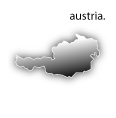 :: Headphone listening in darkness recommended! as the liner notes suggest, indeed! In over an hour Austrian composer Gal (Bernhard Gal) takes apart poetic readings from Swiss ethnopoet and artist Adolf Wölfli’s (1864-1930) work. The distinct marching through dry brush permeates the alternating fore and background. The repetition of consonant phonetics is hollow and disturbing. Singsong children’s voices speak in multiple languages as if memorizing the long poetic passages. Tracks with titles like “Dgiigara” and “Gigrlana” are phrases regularly repeated and at times used as an added rhythm structure. Gal muffles the human voice over footsteps and filtered heavy breath, making for a bold illustration of an outsider artist’s impact, almost a century hence, in the same way that Andrew Liles recently hypothesized about the “twisted” sexual appetite of artist Hans Bellmer (1902-1975) on “Aural Anagram”. Both composers dare to deconstruct the fancy of artists who followed their mind’s eye, whatever the state of that mind. Gal repeats the dark “Uiuiui” phrase using an authoritarian male voice of helium and fire patterned over the other hesitant boys and girls speaking “Zittringim”. For all the whispers and hums, it is no secret that Hinaus: In den, Wald has an eerie Fluxus presence that grabs your unconscious.
:: Headphone listening in darkness recommended! as the liner notes suggest, indeed! In over an hour Austrian composer Gal (Bernhard Gal) takes apart poetic readings from Swiss ethnopoet and artist Adolf Wölfli’s (1864-1930) work. The distinct marching through dry brush permeates the alternating fore and background. The repetition of consonant phonetics is hollow and disturbing. Singsong children’s voices speak in multiple languages as if memorizing the long poetic passages. Tracks with titles like “Dgiigara” and “Gigrlana” are phrases regularly repeated and at times used as an added rhythm structure. Gal muffles the human voice over footsteps and filtered heavy breath, making for a bold illustration of an outsider artist’s impact, almost a century hence, in the same way that Andrew Liles recently hypothesized about the “twisted” sexual appetite of artist Hans Bellmer (1902-1975) on “Aural Anagram”. Both composers dare to deconstruct the fancy of artists who followed their mind’s eye, whatever the state of that mind. Gal repeats the dark “Uiuiui” phrase using an authoritarian male voice of helium and fire patterned over the other hesitant boys and girls speaking “Zittringim”. For all the whispers and hums, it is no secret that Hinaus: In den, Wald has an eerie Fluxus presence that grabs your unconscious.
::..:::…..:..::….:::::..:::..:::::::……:::…::.:::….::::..:..:::…::…….::::
 :: White noise, raw vinyl and feedback all lead into the latest release on London’s handmade TwoThousandAnd imprint. The brittle turntablism and forgotten microphones with their absentee GP3 DJ is forensically manipulated, testing their conduit energies and other power components. Paul Hood’s punk past is analogous in this series of playful noise experiments. Having worked with other faculty of turntable academy, Martin Tetrault, Otomo Yoshide, Martin Ng, Hood is breaking new ground by vamping motors and every element of his instrument. His improvised live work here was recorded in London and Copenhagen. Cplastsics is amped to the nth degree, though it vends unexpected nuances at every turn. At one point on “Primitive Style” it sounds like he is strumming away on an upright bass – though it could be channeled Tupperware given his penchant for found object sounds. As Hood’s first wide-release solo effort this will aptly land in the collections of those who enjoy the output of Ground Fault and 23Five. He scrapes objects to sound like the bloated snore of a sleep apnea sufferer. Though, be forewarned, even though its not all bedlam, unless you can take the heat of Merzbow and some Daniel Menche, this may be for those used to donning fluorescent earplugs.
:: White noise, raw vinyl and feedback all lead into the latest release on London’s handmade TwoThousandAnd imprint. The brittle turntablism and forgotten microphones with their absentee GP3 DJ is forensically manipulated, testing their conduit energies and other power components. Paul Hood’s punk past is analogous in this series of playful noise experiments. Having worked with other faculty of turntable academy, Martin Tetrault, Otomo Yoshide, Martin Ng, Hood is breaking new ground by vamping motors and every element of his instrument. His improvised live work here was recorded in London and Copenhagen. Cplastsics is amped to the nth degree, though it vends unexpected nuances at every turn. At one point on “Primitive Style” it sounds like he is strumming away on an upright bass – though it could be channeled Tupperware given his penchant for found object sounds. As Hood’s first wide-release solo effort this will aptly land in the collections of those who enjoy the output of Ground Fault and 23Five. He scrapes objects to sound like the bloated snore of a sleep apnea sufferer. Though, be forewarned, even though its not all bedlam, unless you can take the heat of Merzbow and some Daniel Menche, this may be for those used to donning fluorescent earplugs.
::..:::…..:..::….:::::..:::..:::::::……:::…::.:::….::::..:..:::…::…….::::
::..:::…..:..::….:::::..:::..:::::::……:::…::.:::….::::..:..:::…::…….::::
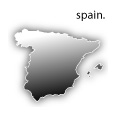 :: Velma is a Lausanne-based multimedia collective who release this splendid headrush called Barcelona. A big wash of cloudy drone is taunted and teased by the fractioned backdrop percussion and tweaked out guitar. The melody piles and erodes to the tap of cymbals on the title track. In just over 21 minutes they use every millimeter of these three inches to fill my ears with obscure pleasantries, as calming as a London fog on Twin Peaks. “Circunflex” shows their taut electronic muscle and penchant for the edge of micronic techno, glitch-click dreaming on a Winter’s day. The enigmatic vocal repeats something about “this place is looking fine” over the half beat, recycled pitch and tone shift. The They Might Be Giantsesque “Stupid” has a nerdy college dude sounding vocal at its center with the bleached fingering of guitars wavering all over the place, and its ending is too abrupt – making it more an excerpt. This is a bit out of place, but show the range of possibilities yet to come from Velma. Granted this release came forth in 2002, but it sounds just as loud and clear (and original) in ’04!
:: Velma is a Lausanne-based multimedia collective who release this splendid headrush called Barcelona. A big wash of cloudy drone is taunted and teased by the fractioned backdrop percussion and tweaked out guitar. The melody piles and erodes to the tap of cymbals on the title track. In just over 21 minutes they use every millimeter of these three inches to fill my ears with obscure pleasantries, as calming as a London fog on Twin Peaks. “Circunflex” shows their taut electronic muscle and penchant for the edge of micronic techno, glitch-click dreaming on a Winter’s day. The enigmatic vocal repeats something about “this place is looking fine” over the half beat, recycled pitch and tone shift. The They Might Be Giantsesque “Stupid” has a nerdy college dude sounding vocal at its center with the bleached fingering of guitars wavering all over the place, and its ending is too abrupt – making it more an excerpt. This is a bit out of place, but show the range of possibilities yet to come from Velma. Granted this release came forth in 2002, but it sounds just as loud and clear (and original) in ’04!
::..:::…..:..::….:::::..:::..:::::::……:::…::.:::….::::..:..:::…::…….::::
 :: As this new Freeform (Simon Pyke) tale opens to the public “Gone & Left the City” has the vestiges of Nick Cave either/or Tom Waits with its bass unreadable vocal about a character who’s “gotta go”. Going on ten years recording, Londoner Freeform has released on the reputable Sub Rosa, Worm Interface, Warp, Nonplace, Quartermass and Skam among others. At nearly 50 minutes this 6-track EP is almost a full-length. “Nothing to Say” is a symphony of playfulness, bubbly synthetic sounds and wind up toy hiccups. The more cautious “Wildcat” is a sitting slacker perched on a corner with multiple width rubber bands, phats and slims – the perfect compliment to “Skim and Skiffle” with its school yard handclaps taunting rasply. The fuzzy-edged vibes purr in echo. The patterns are African, tribal and warmer than the sun. Lighting his long match on “Quadrumble” Pyke blends a near east, (near perfect) facet to this “Wildcat;” it breaths as if through a filter, the small beaded percussion and funky low-end dub mixes smoothly to make this a sexy and unsheltered dance rhythm. With an over-layer of chanted harmonies that are half spoken, half broken the force is with Freeform. In conclusion the croak of “don’t throw me down the hole, don’t throw me in a bowl” speaks from a frog or other endangered voice obviously objecting to its feared objectified domination. Adding a comic relief, the flim-flam animation of “Don’t Put Me In…” just wraps it all up, tighter than any California Roll I’ve bitten into.
:: As this new Freeform (Simon Pyke) tale opens to the public “Gone & Left the City” has the vestiges of Nick Cave either/or Tom Waits with its bass unreadable vocal about a character who’s “gotta go”. Going on ten years recording, Londoner Freeform has released on the reputable Sub Rosa, Worm Interface, Warp, Nonplace, Quartermass and Skam among others. At nearly 50 minutes this 6-track EP is almost a full-length. “Nothing to Say” is a symphony of playfulness, bubbly synthetic sounds and wind up toy hiccups. The more cautious “Wildcat” is a sitting slacker perched on a corner with multiple width rubber bands, phats and slims – the perfect compliment to “Skim and Skiffle” with its school yard handclaps taunting rasply. The fuzzy-edged vibes purr in echo. The patterns are African, tribal and warmer than the sun. Lighting his long match on “Quadrumble” Pyke blends a near east, (near perfect) facet to this “Wildcat;” it breaths as if through a filter, the small beaded percussion and funky low-end dub mixes smoothly to make this a sexy and unsheltered dance rhythm. With an over-layer of chanted harmonies that are half spoken, half broken the force is with Freeform. In conclusion the croak of “don’t throw me down the hole, don’t throw me in a bowl” speaks from a frog or other endangered voice obviously objecting to its feared objectified domination. Adding a comic relief, the flim-flam animation of “Don’t Put Me In…” just wraps it all up, tighter than any California Roll I’ve bitten into.
::..:::…..:..::….:::::..:::..:::::::……:::…::.:::….::::..:..:::…::…….::::
 :: Winnepeg’s Duul_Drv (S. Arden Hill) has refreshed the screen of microtones and brought a garden-fresh variety to the contemporary minimal electronics composition forum. Fade with Consequence contains the natural sounds many take for granted, those under our feet and in the air, true organic happenstance. Dedicating this to the loving memory of a relative, there is the sense of conjuring an elegy to the elements in their honor. Also a painter, Hill’s editing play is surely in union with any brush he wields. I liked his work with Aperstaatje and 12K/line – but this has a quintessential intimacy – as if I am right there in the space, maybe even making the noise myself. Fade with Consequence is, to say simply, rapturous. Dedicated to perhaps some of Hill’s influences and proto-peers is the vibrantly invisible “Blue on Day (for Chartier, Günter and Roden)”. As I listen closely I am recalling experiences of listening to the field recordings of both jfrede and Seth Nehil. But Duul_Drv makes the spoken tongues of the earth, air and various growths a digital transfer, leaving only the outer shavings of the original outdoor scene behind and replicating it in the studio. This is like a tapestry of static electricity that tries hard to remain inaudible, a bit challenging, but effective enough to keep the ears pricked for its 40 plus minutes.
:: Winnepeg’s Duul_Drv (S. Arden Hill) has refreshed the screen of microtones and brought a garden-fresh variety to the contemporary minimal electronics composition forum. Fade with Consequence contains the natural sounds many take for granted, those under our feet and in the air, true organic happenstance. Dedicating this to the loving memory of a relative, there is the sense of conjuring an elegy to the elements in their honor. Also a painter, Hill’s editing play is surely in union with any brush he wields. I liked his work with Aperstaatje and 12K/line – but this has a quintessential intimacy – as if I am right there in the space, maybe even making the noise myself. Fade with Consequence is, to say simply, rapturous. Dedicated to perhaps some of Hill’s influences and proto-peers is the vibrantly invisible “Blue on Day (for Chartier, Günter and Roden)”. As I listen closely I am recalling experiences of listening to the field recordings of both jfrede and Seth Nehil. But Duul_Drv makes the spoken tongues of the earth, air and various growths a digital transfer, leaving only the outer shavings of the original outdoor scene behind and replicating it in the studio. This is like a tapestry of static electricity that tries hard to remain inaudible, a bit challenging, but effective enough to keep the ears pricked for its 40 plus minutes.
::..:::…..:..::….:::::..:::..:::::::……:::…::.:::….::::..:..:::…::…….::::
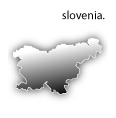 :: Oo la la! This is a very French record. Is that OK to say? After the opening Philip Glass meets “On the Corner” era Miles Davis, Pernice and Barberi flicker like two crazy birds of different feathers flying against a the cylindrical forcefield of wind. But, unfortunately after an interesting, reaching start the scmaltz of contemporary jazz lite rears its hideous head. This is should I say, le “jazzy”. It’s sort of pageant jazz, (smooth, lite or whatever its current marketing moniker is). But its not JUST that. Drosophiles et Doryphores suffers from a genre collision, rather than a bent. Sure, the playing is fine, and the saxophone is particularly harmonic and sexy – but it’s the arrangements that seem misguided, lapsing in creativity along some more formulaic commercial end, especially on the sappy “Octave Moins Un.” This is mood music, and in another application, say film score perhaps, it may work well. Here I feel it’s a catalyst for my early high school memories of walking into a local mall and being assaulted by the man behind the “legendary” Wurlitzer organ! So, you see, it scares me. This just isn’t a style of music that is in my interest; A bit too on par with elements of regional new age and other outsider folk. This may appeal to lovers of Sade (sans vocal) and (even though it hurts to even print the name but I have to make the reference) Kenny G.
:: Oo la la! This is a very French record. Is that OK to say? After the opening Philip Glass meets “On the Corner” era Miles Davis, Pernice and Barberi flicker like two crazy birds of different feathers flying against a the cylindrical forcefield of wind. But, unfortunately after an interesting, reaching start the scmaltz of contemporary jazz lite rears its hideous head. This is should I say, le “jazzy”. It’s sort of pageant jazz, (smooth, lite or whatever its current marketing moniker is). But its not JUST that. Drosophiles et Doryphores suffers from a genre collision, rather than a bent. Sure, the playing is fine, and the saxophone is particularly harmonic and sexy – but it’s the arrangements that seem misguided, lapsing in creativity along some more formulaic commercial end, especially on the sappy “Octave Moins Un.” This is mood music, and in another application, say film score perhaps, it may work well. Here I feel it’s a catalyst for my early high school memories of walking into a local mall and being assaulted by the man behind the “legendary” Wurlitzer organ! So, you see, it scares me. This just isn’t a style of music that is in my interest; A bit too on par with elements of regional new age and other outsider folk. This may appeal to lovers of Sade (sans vocal) and (even though it hurts to even print the name but I have to make the reference) Kenny G.
::..:::…..:..::….:::::..:::..:::::::……:::…::.:::….::::..:..:::…::…….::::
Essential Links ::
::..:::…..:..::….:::::..:::..:::::::……:::…::.:::….::::..:..:::…::…….::::
Read more Microview’s ::






